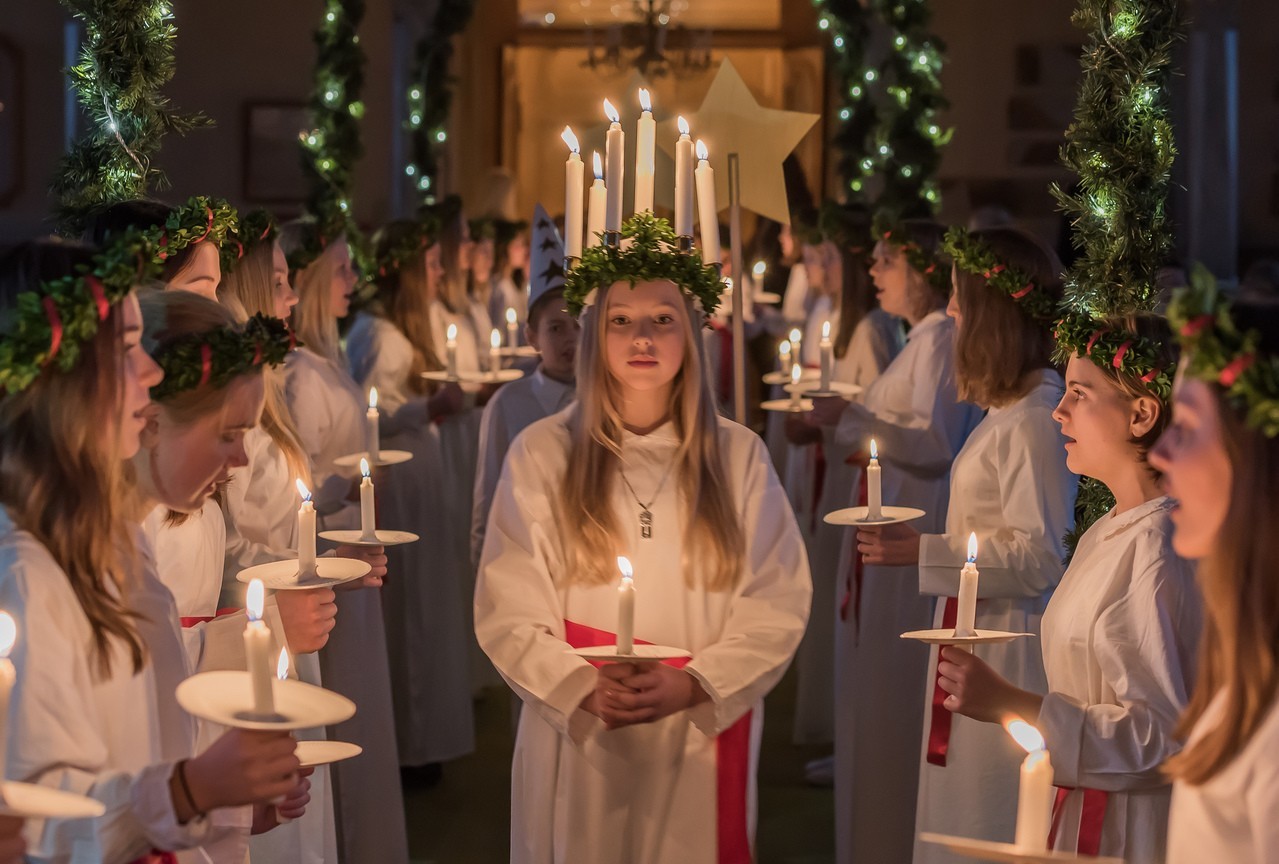聖露西亞節
簡介
聖露西亞節(Saint Lucia's Day),是瑞典傳統節日,設在每年的12月13日,又稱瑞典露西亞日。
依據瑞典傳統曆法,12月13日被認為是一年中最長和最黑的夜晚。而12月13日過後,夜晚時間開始縮短,白晝時間漸漸增加,象徵著光明,所以瑞典人以節日的方式慶祝這一天,並把這一天稱為「迎光節」。
瑞典人十分重視聖露西亞節,每當12月一到,瑞典城鄉大小商店便開始供應節日用品,其中銷量最大的是蠟燭花冠和露西亞裝。
聖露西亞節,是在將臨期(耶穌聖誕前的準備期與等待期)中的12月13日,是斯堪的納維亞會慶祝的節日。
瑞典地處高緯度的北歐地區,冬季漫長,白晝時間僅有幾個小時。 瑞典北部位於北極圈內的基律納地區,終日不見陽光。瑞典從11月起就漸漸被無邊無際的黑暗與寒冷籠罩,戲劇《冰與火之歌》中人人朗朗上口的台詞,在這裡不只是一句逗趣的台詞,而是準備迎接冬季的瑞典人口中一句十分寫實,對現實充滿無奈、絕望、與辛酸的招呼語。
好在12月13日的露西亞節(Luciadagen)給被黑暗籠罩的瑞典帶來美麗的音樂,以及光明與希望,無論冬季的黑暗與寒冷多麼漫長,傳說中來自義大利西西里的聖女露西亞都會帶領人們走出絕望。這個充滿光明與希望的冬令節慶深受瑞典人喜愛。
歷史傳說
傳說:(一)
露西亞是羅馬帝國某官員的夫人,約出生在公元2世紀,熱衷信奉基督教。
那時候,羅馬當局對基督教十分仇視,派人刺瞎了露西亞的雙眼,露西亞雖遭不幸,但仍虔誠地祈求著光明,不久終於出現了奇蹟:露西亞睜開了雙眼,重見了光明。
以後,心地善良美好的露西並被人們尊為聖女。
關於她的傳說也一同隨基督教傳入瑞典,為了紀念露西亞,瑞典人民以她的名字舉辦節日。
傳說:(二)
聖露西是第三世紀的基督徒烈士(Christian martyr),死於戴克里先迫害[2],依照基督教的傳統,她 「帶食物給藏在地下墓穴的基督徒,並且幫助他們,她頭上戴著上面有蠟燭的花圈,讓手空出來,可以多拿一些食物」[3][4]。
傳說:(三)
有人認為露西亞的名字來自西元4世紀一個義大利西西里的女殉道者,相傳她在生前幫助窮苦的囚犯,被認為是光明與希望的象徵,也有一說認為露西亞這個名稱可能跟基督教的惡魔路西法(Lucifer)有關。
聖露西亞節曾經和冬至重疊,也就是一年之中白天最短的一天,所以聖露西亞節也成為基督教光明的節日[5][6]。
在將臨期的開始,聖露西亞節表示了聖誕節期(Christmastid)的開始,也就是預告了聖誕節基督之光的到來[2][7]。
外部連結
註解
- Eriksson, Stig A. (2002). Christmas traditions and performance rituals: a look at Christmas celebrations in a Nordic context. 2002. Applied Theater Researcher. No. 3. 6/3
- Nygaard, J. (1992). Teatrets historie i Europa ("~ History in Europe"). Volume 1. Oslo: Spillerom.
- NRK radio (2002). Språkteigen. NRK radio. December 2002.
參考資料
- ↑ 聖露西亞節,百科知識中文網
- ↑ 2.0 2.1 Hynes, Mary Ellen; Mazar, Peter. Companion to the Calendar. Liturgy Training Publications. 1993: 186 [12 December 2015]. ISBN 978-156854011-5.
Lucy's name means light. Coming midway through Advent, her feast day guides our hope towards the coming of Christ our Light. Lucy was a young woman of Syracuse in Sicily (an island off the southern coast of Italy). We know she died a martyr during the persecutions by the Roman emperor Diocletian.
- ↑ Barnhill, Carla. St. Lucy’s Day. Christian History Magazine.
- ↑ Hanson, Joelle. Santa Lucia Day traditions. ELCA. 13 December 2012 [12 December 2015]. (原始內容存檔於2015-12-22).
Lucia means "light" and Santa Lucia became associated with light. In northern Europe, particularly Scandinavia, Spain and the Canary Islands, and her day fell on the shortest day of the year and was celebrated as they turned from the long winter nights and began to look forward to longer days. During the Roman persecutions, Lucia is said to have carried food to the poor in dark tunnels, wearing a wreath of candles on her head.
- ↑ St. Lucy. St. Lucy's Church, Scranton, Pennsylvania. [13 December 2014]. (原始內容存檔於2015-03-06).
- ↑ Crump, William D. The Christmas Encyclopedia 3rd. Jefferson, NC: McFarland & Company. 2006. ISBN 978-0-7864-2293-7.
Prior to the adoption of the Gregorian calendar in the sixteenth century, St. Lucy's Day fell on the winter solstice, which poses a factor in her association with light, and her day Christianized a day formerly associated with the pagan Germanic goddess Berchta ...
- ↑ Hanson, Joelle. Santa Lucia Day traditions. ELCA. 13 December 2012 [12 December 2015]. (原始內容存檔於2015-12-22).
The tradition of planting wheat on St. Lucy's Day comes from Hungary, Croatia and other European nations. Plant wheat grains in a round dish or plate of soil, then water the seeds. Place the container in a warm spot. If the planting medium is kept moist (not sopping wet), the seeds will germinate and the shoots will be several inches high by Christmas. Then the new green shoots, reminding us of the new life born in Bethlehem, may be tied with a ribbon, if desired, and a candle may be placed near them as a symbol of the Light of Christ.
